Leadership Styles and Strategic Implementation at Tesco: A Report
VerifiedAdded on 2020/10/22
|10
|2746
|52
Report
AI Summary
This report provides an analysis of Tesco's leadership, focusing on its history, vision, leadership style, and management practices. The report examines Tesco's implementation of various strategies and links them to leadership theories such as Herzberg's motivational and hygiene factors, and John Adair's Action-Centered leadership theory. The report highlights Tesco's democratic leadership style and management practices including engaging workers, clarity, team effort, and regular meetings. The study explores Tesco's strategies for motivating employees through recognition, responsibility, and team building. The report concludes with recommendations for Tesco to improve its management practices, including simplifying the implementation of theories, accepting conflicts, and improving communication and transparency. The report emphasizes the importance of effective leadership in achieving organizational goals within a competitive market.
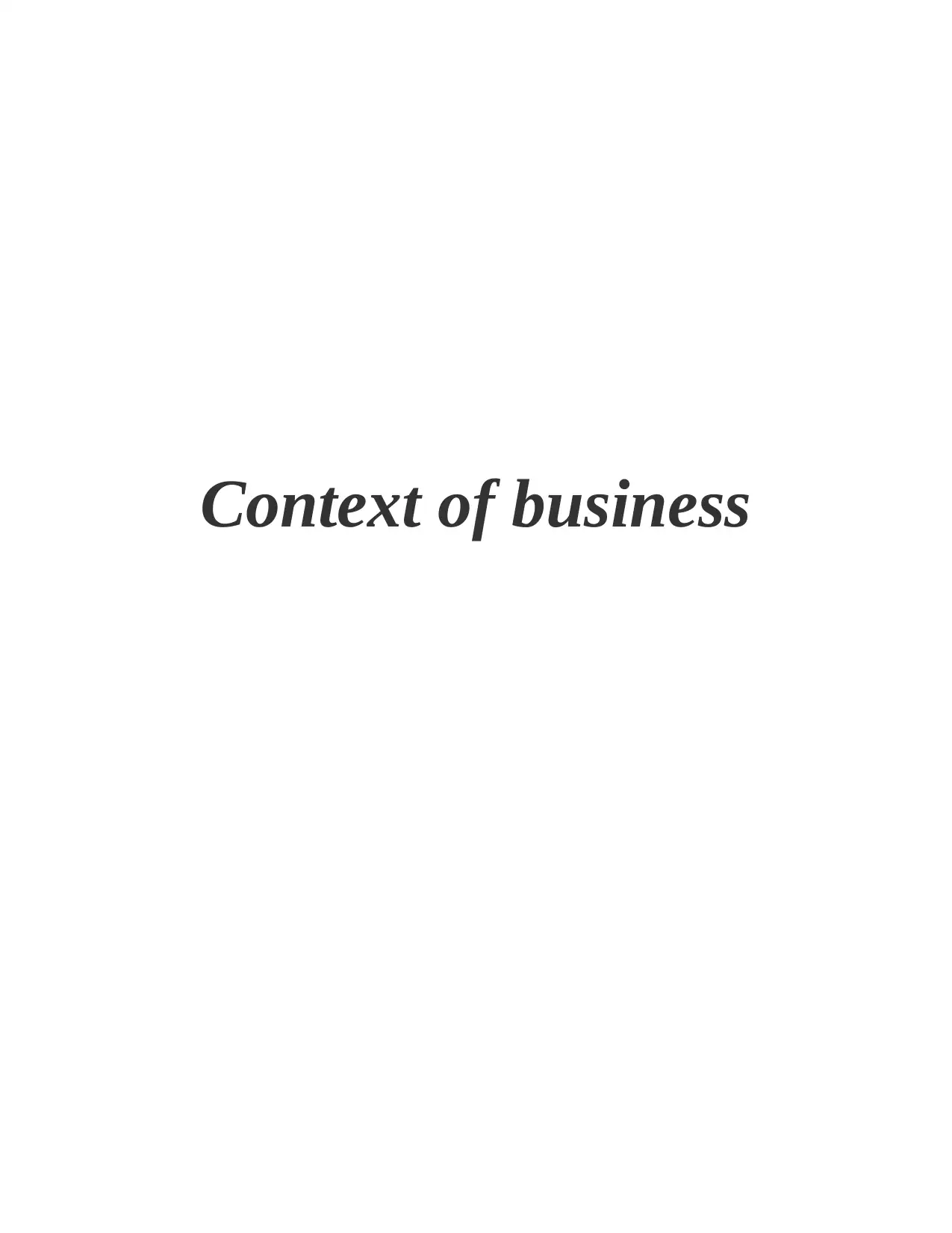
Context of business
Paraphrase This Document
Need a fresh take? Get an instant paraphrase of this document with our AI Paraphraser

Table of Contents
INTRODUCTION...........................................................................................................................1
Main Body.......................................................................................................................................2
1. History And Summary Of The Business.................................................................................2
2. Vision, leadership style and management practices of Tesco.................................................3
3. Implementation of Various Strategies in Tesco......................................................................5
4. Recommendations ..................................................................................................................6
CONCLUSION................................................................................................................................6
REFERENCES................................................................................................................................8
INTRODUCTION...........................................................................................................................1
Main Body.......................................................................................................................................2
1. History And Summary Of The Business.................................................................................2
2. Vision, leadership style and management practices of Tesco.................................................3
3. Implementation of Various Strategies in Tesco......................................................................5
4. Recommendations ..................................................................................................................6
CONCLUSION................................................................................................................................6
REFERENCES................................................................................................................................8

INTRODUCTION
Leadership provides direction to the management in achieving goals. Employees and
organisation need to have a guiding way in order to achieve goals and objectives that can only be
attained by effective leadership (Fleisher and Bensoussan, 2015). A manager is known by their
leadership skills as how their subordinates react to the directions given by manager, whether it
has a positive impact on the organisation or negative. It is very crucial to understand leadership
style in the context of business to know the effectiveness of that organisation. In the following
report, vision, mission and leadership style of Tesco is studied in order to obtain the relation
between leadership and the various strategies implemented by Tesco.
1
Leadership provides direction to the management in achieving goals. Employees and
organisation need to have a guiding way in order to achieve goals and objectives that can only be
attained by effective leadership (Fleisher and Bensoussan, 2015). A manager is known by their
leadership skills as how their subordinates react to the directions given by manager, whether it
has a positive impact on the organisation or negative. It is very crucial to understand leadership
style in the context of business to know the effectiveness of that organisation. In the following
report, vision, mission and leadership style of Tesco is studied in order to obtain the relation
between leadership and the various strategies implemented by Tesco.
1
⊘ This is a preview!⊘
Do you want full access?
Subscribe today to unlock all pages.

Trusted by 1+ million students worldwide
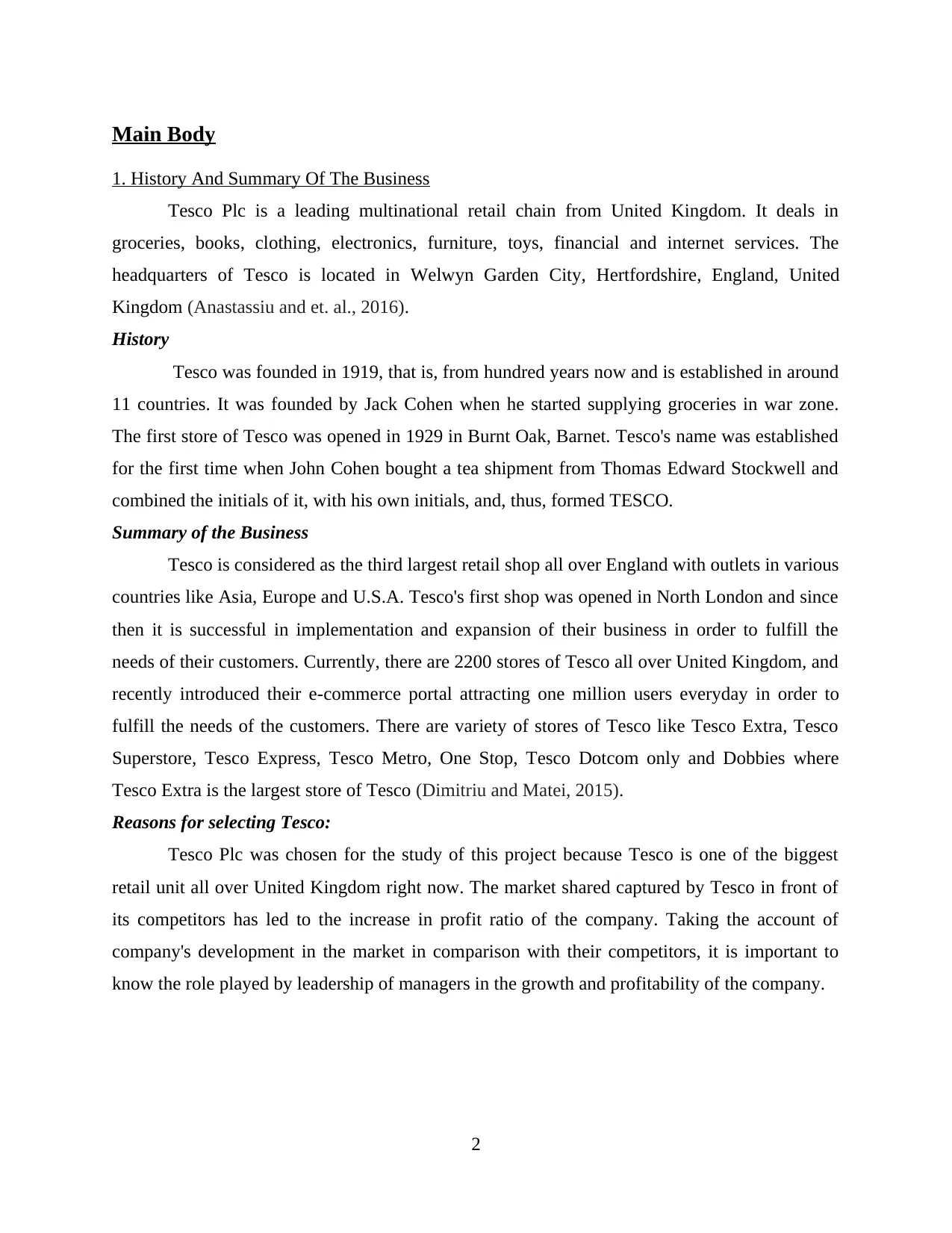
Main Body
1. History And Summary Of The Business
Tesco Plc is a leading multinational retail chain from United Kingdom. It deals in
groceries, books, clothing, electronics, furniture, toys, financial and internet services. The
headquarters of Tesco is located in Welwyn Garden City, Hertfordshire, England, United
Kingdom (Anastassiu and et. al., 2016).
History
Tesco was founded in 1919, that is, from hundred years now and is established in around
11 countries. It was founded by Jack Cohen when he started supplying groceries in war zone.
The first store of Tesco was opened in 1929 in Burnt Oak, Barnet. Tesco's name was established
for the first time when John Cohen bought a tea shipment from Thomas Edward Stockwell and
combined the initials of it, with his own initials, and, thus, formed TESCO.
Summary of the Business
Tesco is considered as the third largest retail shop all over England with outlets in various
countries like Asia, Europe and U.S.A. Tesco's first shop was opened in North London and since
then it is successful in implementation and expansion of their business in order to fulfill the
needs of their customers. Currently, there are 2200 stores of Tesco all over United Kingdom, and
recently introduced their e-commerce portal attracting one million users everyday in order to
fulfill the needs of the customers. There are variety of stores of Tesco like Tesco Extra, Tesco
Superstore, Tesco Express, Tesco Metro, One Stop, Tesco Dotcom only and Dobbies where
Tesco Extra is the largest store of Tesco (Dimitriu and Matei, 2015).
Reasons for selecting Tesco:
Tesco Plc was chosen for the study of this project because Tesco is one of the biggest
retail unit all over United Kingdom right now. The market shared captured by Tesco in front of
its competitors has led to the increase in profit ratio of the company. Taking the account of
company's development in the market in comparison with their competitors, it is important to
know the role played by leadership of managers in the growth and profitability of the company.
2
1. History And Summary Of The Business
Tesco Plc is a leading multinational retail chain from United Kingdom. It deals in
groceries, books, clothing, electronics, furniture, toys, financial and internet services. The
headquarters of Tesco is located in Welwyn Garden City, Hertfordshire, England, United
Kingdom (Anastassiu and et. al., 2016).
History
Tesco was founded in 1919, that is, from hundred years now and is established in around
11 countries. It was founded by Jack Cohen when he started supplying groceries in war zone.
The first store of Tesco was opened in 1929 in Burnt Oak, Barnet. Tesco's name was established
for the first time when John Cohen bought a tea shipment from Thomas Edward Stockwell and
combined the initials of it, with his own initials, and, thus, formed TESCO.
Summary of the Business
Tesco is considered as the third largest retail shop all over England with outlets in various
countries like Asia, Europe and U.S.A. Tesco's first shop was opened in North London and since
then it is successful in implementation and expansion of their business in order to fulfill the
needs of their customers. Currently, there are 2200 stores of Tesco all over United Kingdom, and
recently introduced their e-commerce portal attracting one million users everyday in order to
fulfill the needs of the customers. There are variety of stores of Tesco like Tesco Extra, Tesco
Superstore, Tesco Express, Tesco Metro, One Stop, Tesco Dotcom only and Dobbies where
Tesco Extra is the largest store of Tesco (Dimitriu and Matei, 2015).
Reasons for selecting Tesco:
Tesco Plc was chosen for the study of this project because Tesco is one of the biggest
retail unit all over United Kingdom right now. The market shared captured by Tesco in front of
its competitors has led to the increase in profit ratio of the company. Taking the account of
company's development in the market in comparison with their competitors, it is important to
know the role played by leadership of managers in the growth and profitability of the company.
2
Paraphrase This Document
Need a fresh take? Get an instant paraphrase of this document with our AI Paraphraser
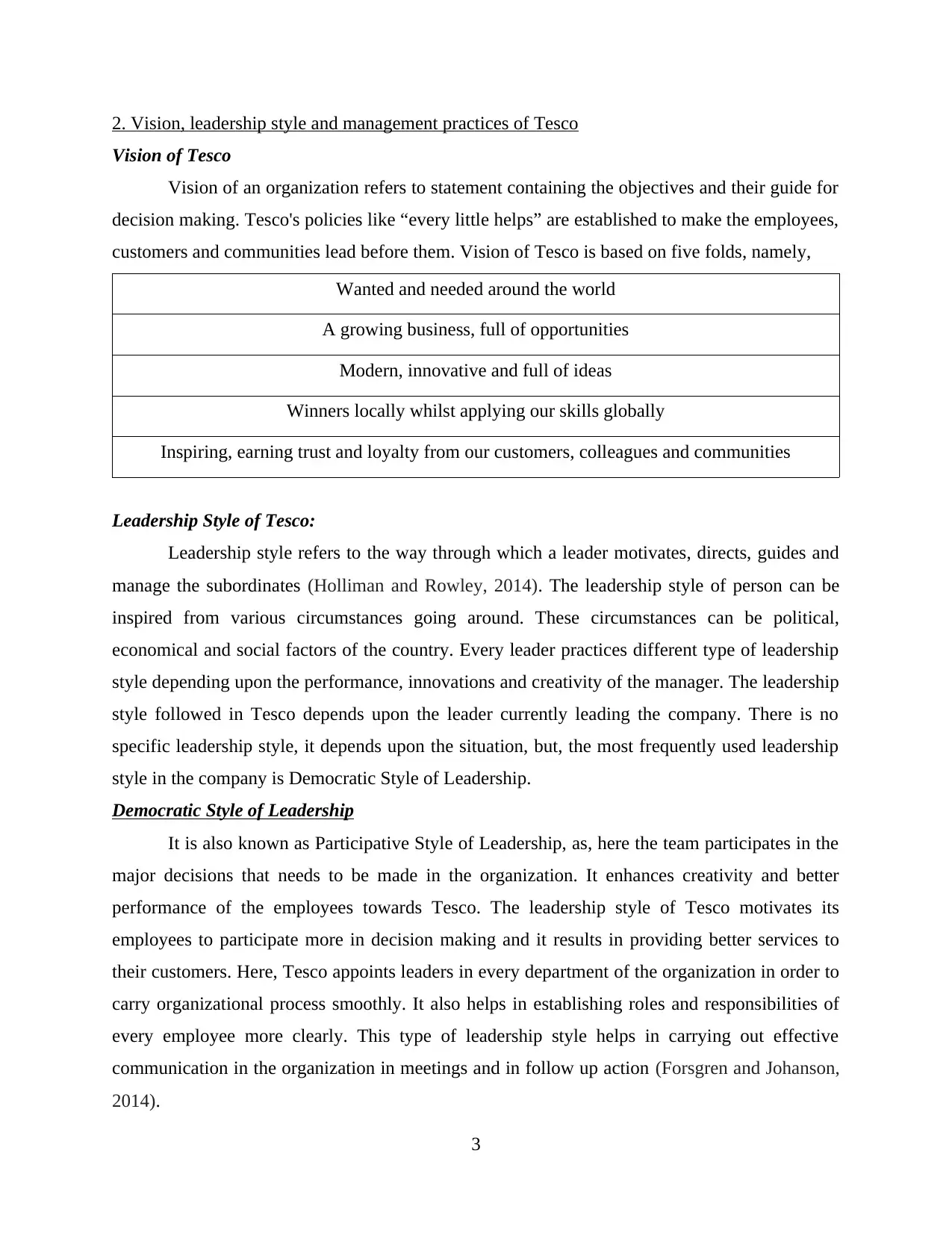
2. Vision, leadership style and management practices of Tesco
Vision of Tesco
Vision of an organization refers to statement containing the objectives and their guide for
decision making. Tesco's policies like “every little helps” are established to make the employees,
customers and communities lead before them. Vision of Tesco is based on five folds, namely,
Wanted and needed around the world
A growing business, full of opportunities
Modern, innovative and full of ideas
Winners locally whilst applying our skills globally
Inspiring, earning trust and loyalty from our customers, colleagues and communities
Leadership Style of Tesco:
Leadership style refers to the way through which a leader motivates, directs, guides and
manage the subordinates (Holliman and Rowley, 2014). The leadership style of person can be
inspired from various circumstances going around. These circumstances can be political,
economical and social factors of the country. Every leader practices different type of leadership
style depending upon the performance, innovations and creativity of the manager. The leadership
style followed in Tesco depends upon the leader currently leading the company. There is no
specific leadership style, it depends upon the situation, but, the most frequently used leadership
style in the company is Democratic Style of Leadership.
Democratic Style of Leadership
It is also known as Participative Style of Leadership, as, here the team participates in the
major decisions that needs to be made in the organization. It enhances creativity and better
performance of the employees towards Tesco. The leadership style of Tesco motivates its
employees to participate more in decision making and it results in providing better services to
their customers. Here, Tesco appoints leaders in every department of the organization in order to
carry organizational process smoothly. It also helps in establishing roles and responsibilities of
every employee more clearly. This type of leadership style helps in carrying out effective
communication in the organization in meetings and in follow up action (Forsgren and Johanson,
2014).
3
Vision of Tesco
Vision of an organization refers to statement containing the objectives and their guide for
decision making. Tesco's policies like “every little helps” are established to make the employees,
customers and communities lead before them. Vision of Tesco is based on five folds, namely,
Wanted and needed around the world
A growing business, full of opportunities
Modern, innovative and full of ideas
Winners locally whilst applying our skills globally
Inspiring, earning trust and loyalty from our customers, colleagues and communities
Leadership Style of Tesco:
Leadership style refers to the way through which a leader motivates, directs, guides and
manage the subordinates (Holliman and Rowley, 2014). The leadership style of person can be
inspired from various circumstances going around. These circumstances can be political,
economical and social factors of the country. Every leader practices different type of leadership
style depending upon the performance, innovations and creativity of the manager. The leadership
style followed in Tesco depends upon the leader currently leading the company. There is no
specific leadership style, it depends upon the situation, but, the most frequently used leadership
style in the company is Democratic Style of Leadership.
Democratic Style of Leadership
It is also known as Participative Style of Leadership, as, here the team participates in the
major decisions that needs to be made in the organization. It enhances creativity and better
performance of the employees towards Tesco. The leadership style of Tesco motivates its
employees to participate more in decision making and it results in providing better services to
their customers. Here, Tesco appoints leaders in every department of the organization in order to
carry organizational process smoothly. It also helps in establishing roles and responsibilities of
every employee more clearly. This type of leadership style helps in carrying out effective
communication in the organization in meetings and in follow up action (Forsgren and Johanson,
2014).
3
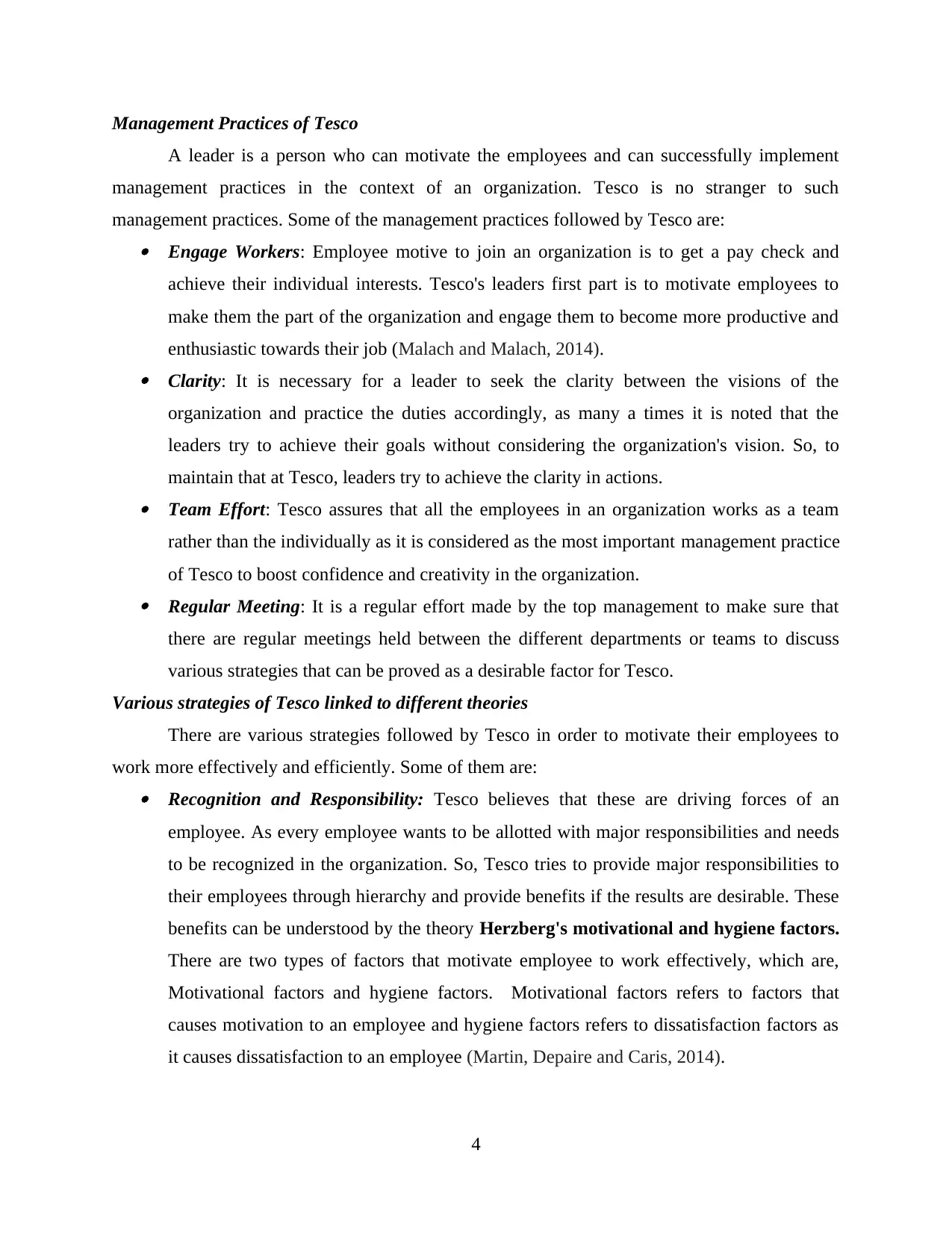
Management Practices of Tesco
A leader is a person who can motivate the employees and can successfully implement
management practices in the context of an organization. Tesco is no stranger to such
management practices. Some of the management practices followed by Tesco are: Engage Workers: Employee motive to join an organization is to get a pay check and
achieve their individual interests. Tesco's leaders first part is to motivate employees to
make them the part of the organization and engage them to become more productive and
enthusiastic towards their job (Malach and Malach, 2014). Clarity: It is necessary for a leader to seek the clarity between the visions of the
organization and practice the duties accordingly, as many a times it is noted that the
leaders try to achieve their goals without considering the organization's vision. So, to
maintain that at Tesco, leaders try to achieve the clarity in actions. Team Effort: Tesco assures that all the employees in an organization works as a team
rather than the individually as it is considered as the most important management practice
of Tesco to boost confidence and creativity in the organization. Regular Meeting: It is a regular effort made by the top management to make sure that
there are regular meetings held between the different departments or teams to discuss
various strategies that can be proved as a desirable factor for Tesco.
Various strategies of Tesco linked to different theories
There are various strategies followed by Tesco in order to motivate their employees to
work more effectively and efficiently. Some of them are: Recognition and Responsibility: Tesco believes that these are driving forces of an
employee. As every employee wants to be allotted with major responsibilities and needs
to be recognized in the organization. So, Tesco tries to provide major responsibilities to
their employees through hierarchy and provide benefits if the results are desirable. These
benefits can be understood by the theory Herzberg's motivational and hygiene factors.
There are two types of factors that motivate employee to work effectively, which are,
Motivational factors and hygiene factors. Motivational factors refers to factors that
causes motivation to an employee and hygiene factors refers to dissatisfaction factors as
it causes dissatisfaction to an employee (Martin, Depaire and Caris, 2014).
4
A leader is a person who can motivate the employees and can successfully implement
management practices in the context of an organization. Tesco is no stranger to such
management practices. Some of the management practices followed by Tesco are: Engage Workers: Employee motive to join an organization is to get a pay check and
achieve their individual interests. Tesco's leaders first part is to motivate employees to
make them the part of the organization and engage them to become more productive and
enthusiastic towards their job (Malach and Malach, 2014). Clarity: It is necessary for a leader to seek the clarity between the visions of the
organization and practice the duties accordingly, as many a times it is noted that the
leaders try to achieve their goals without considering the organization's vision. So, to
maintain that at Tesco, leaders try to achieve the clarity in actions. Team Effort: Tesco assures that all the employees in an organization works as a team
rather than the individually as it is considered as the most important management practice
of Tesco to boost confidence and creativity in the organization. Regular Meeting: It is a regular effort made by the top management to make sure that
there are regular meetings held between the different departments or teams to discuss
various strategies that can be proved as a desirable factor for Tesco.
Various strategies of Tesco linked to different theories
There are various strategies followed by Tesco in order to motivate their employees to
work more effectively and efficiently. Some of them are: Recognition and Responsibility: Tesco believes that these are driving forces of an
employee. As every employee wants to be allotted with major responsibilities and needs
to be recognized in the organization. So, Tesco tries to provide major responsibilities to
their employees through hierarchy and provide benefits if the results are desirable. These
benefits can be understood by the theory Herzberg's motivational and hygiene factors.
There are two types of factors that motivate employee to work effectively, which are,
Motivational factors and hygiene factors. Motivational factors refers to factors that
causes motivation to an employee and hygiene factors refers to dissatisfaction factors as
it causes dissatisfaction to an employee (Martin, Depaire and Caris, 2014).
4
⊘ This is a preview!⊘
Do you want full access?
Subscribe today to unlock all pages.

Trusted by 1+ million students worldwide
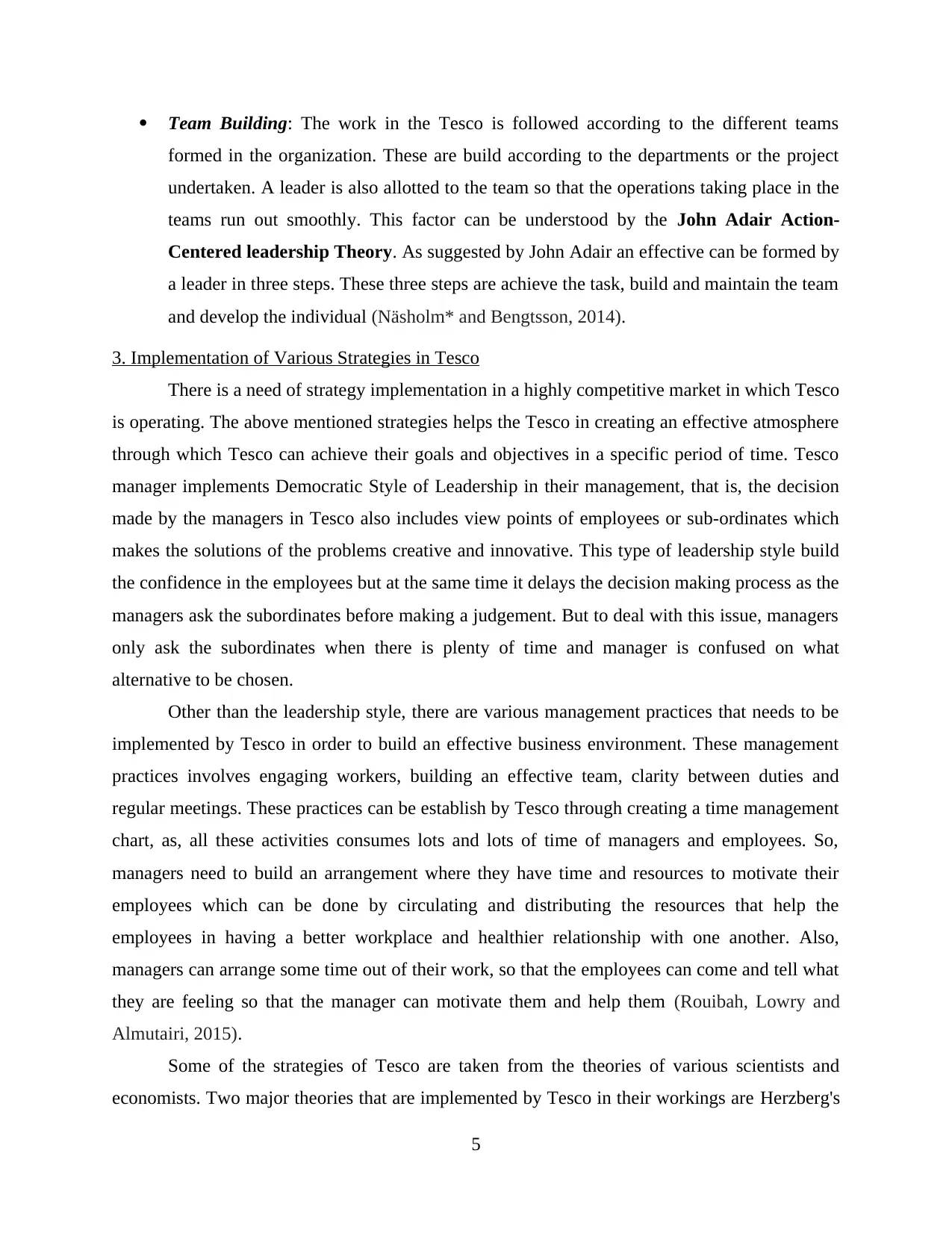
Team Building: The work in the Tesco is followed according to the different teams
formed in the organization. These are build according to the departments or the project
undertaken. A leader is also allotted to the team so that the operations taking place in the
teams run out smoothly. This factor can be understood by the John Adair Action-
Centered leadership Theory. As suggested by John Adair an effective can be formed by
a leader in three steps. These three steps are achieve the task, build and maintain the team
and develop the individual (Näsholm* and Bengtsson, 2014).
3. Implementation of Various Strategies in Tesco
There is a need of strategy implementation in a highly competitive market in which Tesco
is operating. The above mentioned strategies helps the Tesco in creating an effective atmosphere
through which Tesco can achieve their goals and objectives in a specific period of time. Tesco
manager implements Democratic Style of Leadership in their management, that is, the decision
made by the managers in Tesco also includes view points of employees or sub-ordinates which
makes the solutions of the problems creative and innovative. This type of leadership style build
the confidence in the employees but at the same time it delays the decision making process as the
managers ask the subordinates before making a judgement. But to deal with this issue, managers
only ask the subordinates when there is plenty of time and manager is confused on what
alternative to be chosen.
Other than the leadership style, there are various management practices that needs to be
implemented by Tesco in order to build an effective business environment. These management
practices involves engaging workers, building an effective team, clarity between duties and
regular meetings. These practices can be establish by Tesco through creating a time management
chart, as, all these activities consumes lots and lots of time of managers and employees. So,
managers need to build an arrangement where they have time and resources to motivate their
employees which can be done by circulating and distributing the resources that help the
employees in having a better workplace and healthier relationship with one another. Also,
managers can arrange some time out of their work, so that the employees can come and tell what
they are feeling so that the manager can motivate them and help them (Rouibah, Lowry and
Almutairi, 2015).
Some of the strategies of Tesco are taken from the theories of various scientists and
economists. Two major theories that are implemented by Tesco in their workings are Herzberg's
5
formed in the organization. These are build according to the departments or the project
undertaken. A leader is also allotted to the team so that the operations taking place in the
teams run out smoothly. This factor can be understood by the John Adair Action-
Centered leadership Theory. As suggested by John Adair an effective can be formed by
a leader in three steps. These three steps are achieve the task, build and maintain the team
and develop the individual (Näsholm* and Bengtsson, 2014).
3. Implementation of Various Strategies in Tesco
There is a need of strategy implementation in a highly competitive market in which Tesco
is operating. The above mentioned strategies helps the Tesco in creating an effective atmosphere
through which Tesco can achieve their goals and objectives in a specific period of time. Tesco
manager implements Democratic Style of Leadership in their management, that is, the decision
made by the managers in Tesco also includes view points of employees or sub-ordinates which
makes the solutions of the problems creative and innovative. This type of leadership style build
the confidence in the employees but at the same time it delays the decision making process as the
managers ask the subordinates before making a judgement. But to deal with this issue, managers
only ask the subordinates when there is plenty of time and manager is confused on what
alternative to be chosen.
Other than the leadership style, there are various management practices that needs to be
implemented by Tesco in order to build an effective business environment. These management
practices involves engaging workers, building an effective team, clarity between duties and
regular meetings. These practices can be establish by Tesco through creating a time management
chart, as, all these activities consumes lots and lots of time of managers and employees. So,
managers need to build an arrangement where they have time and resources to motivate their
employees which can be done by circulating and distributing the resources that help the
employees in having a better workplace and healthier relationship with one another. Also,
managers can arrange some time out of their work, so that the employees can come and tell what
they are feeling so that the manager can motivate them and help them (Rouibah, Lowry and
Almutairi, 2015).
Some of the strategies of Tesco are taken from the theories of various scientists and
economists. Two major theories that are implemented by Tesco in their workings are Herzberg's
5
Paraphrase This Document
Need a fresh take? Get an instant paraphrase of this document with our AI Paraphraser
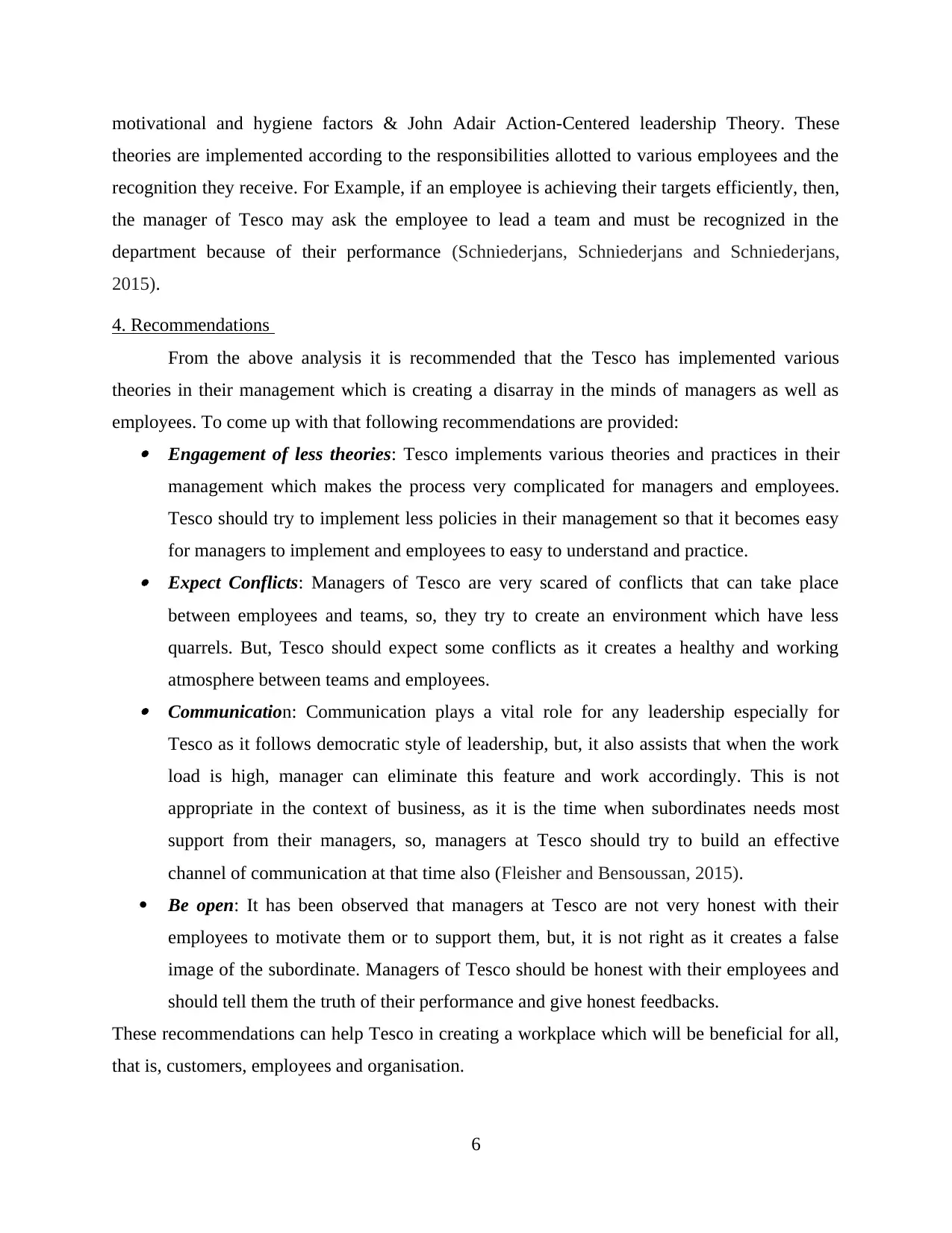
motivational and hygiene factors & John Adair Action-Centered leadership Theory. These
theories are implemented according to the responsibilities allotted to various employees and the
recognition they receive. For Example, if an employee is achieving their targets efficiently, then,
the manager of Tesco may ask the employee to lead a team and must be recognized in the
department because of their performance (Schniederjans, Schniederjans and Schniederjans,
2015).
4. Recommendations
From the above analysis it is recommended that the Tesco has implemented various
theories in their management which is creating a disarray in the minds of managers as well as
employees. To come up with that following recommendations are provided: Engagement of less theories: Tesco implements various theories and practices in their
management which makes the process very complicated for managers and employees.
Tesco should try to implement less policies in their management so that it becomes easy
for managers to implement and employees to easy to understand and practice. Expect Conflicts: Managers of Tesco are very scared of conflicts that can take place
between employees and teams, so, they try to create an environment which have less
quarrels. But, Tesco should expect some conflicts as it creates a healthy and working
atmosphere between teams and employees. Communication: Communication plays a vital role for any leadership especially for
Tesco as it follows democratic style of leadership, but, it also assists that when the work
load is high, manager can eliminate this feature and work accordingly. This is not
appropriate in the context of business, as it is the time when subordinates needs most
support from their managers, so, managers at Tesco should try to build an effective
channel of communication at that time also (Fleisher and Bensoussan, 2015).
Be open: It has been observed that managers at Tesco are not very honest with their
employees to motivate them or to support them, but, it is not right as it creates a false
image of the subordinate. Managers of Tesco should be honest with their employees and
should tell them the truth of their performance and give honest feedbacks.
These recommendations can help Tesco in creating a workplace which will be beneficial for all,
that is, customers, employees and organisation.
6
theories are implemented according to the responsibilities allotted to various employees and the
recognition they receive. For Example, if an employee is achieving their targets efficiently, then,
the manager of Tesco may ask the employee to lead a team and must be recognized in the
department because of their performance (Schniederjans, Schniederjans and Schniederjans,
2015).
4. Recommendations
From the above analysis it is recommended that the Tesco has implemented various
theories in their management which is creating a disarray in the minds of managers as well as
employees. To come up with that following recommendations are provided: Engagement of less theories: Tesco implements various theories and practices in their
management which makes the process very complicated for managers and employees.
Tesco should try to implement less policies in their management so that it becomes easy
for managers to implement and employees to easy to understand and practice. Expect Conflicts: Managers of Tesco are very scared of conflicts that can take place
between employees and teams, so, they try to create an environment which have less
quarrels. But, Tesco should expect some conflicts as it creates a healthy and working
atmosphere between teams and employees. Communication: Communication plays a vital role for any leadership especially for
Tesco as it follows democratic style of leadership, but, it also assists that when the work
load is high, manager can eliminate this feature and work accordingly. This is not
appropriate in the context of business, as it is the time when subordinates needs most
support from their managers, so, managers at Tesco should try to build an effective
channel of communication at that time also (Fleisher and Bensoussan, 2015).
Be open: It has been observed that managers at Tesco are not very honest with their
employees to motivate them or to support them, but, it is not right as it creates a false
image of the subordinate. Managers of Tesco should be honest with their employees and
should tell them the truth of their performance and give honest feedbacks.
These recommendations can help Tesco in creating a workplace which will be beneficial for all,
that is, customers, employees and organisation.
6

CONCLUSION
From the above report it can be concluded that leadership styles create a huge difference
on the workings of an organisation in order to establish an effective business environment. The
implementation of different theories and practices helps in creating a better relationship and
atmosphere for the employees and managers. Though, implementation of various strategies
makes the process complicated for managers and employees, but, implementation of right
number of strategies can make the process easier for all. In the context of this report,
establishment of democratic style of leadership and Herzberg's motivational and hygiene factors
motivates employees and directs them to work at the level desirable for the organization.
7
From the above report it can be concluded that leadership styles create a huge difference
on the workings of an organisation in order to establish an effective business environment. The
implementation of different theories and practices helps in creating a better relationship and
atmosphere for the employees and managers. Though, implementation of various strategies
makes the process complicated for managers and employees, but, implementation of right
number of strategies can make the process easier for all. In the context of this report,
establishment of democratic style of leadership and Herzberg's motivational and hygiene factors
motivates employees and directs them to work at the level desirable for the organization.
7
⊘ This is a preview!⊘
Do you want full access?
Subscribe today to unlock all pages.

Trusted by 1+ million students worldwide
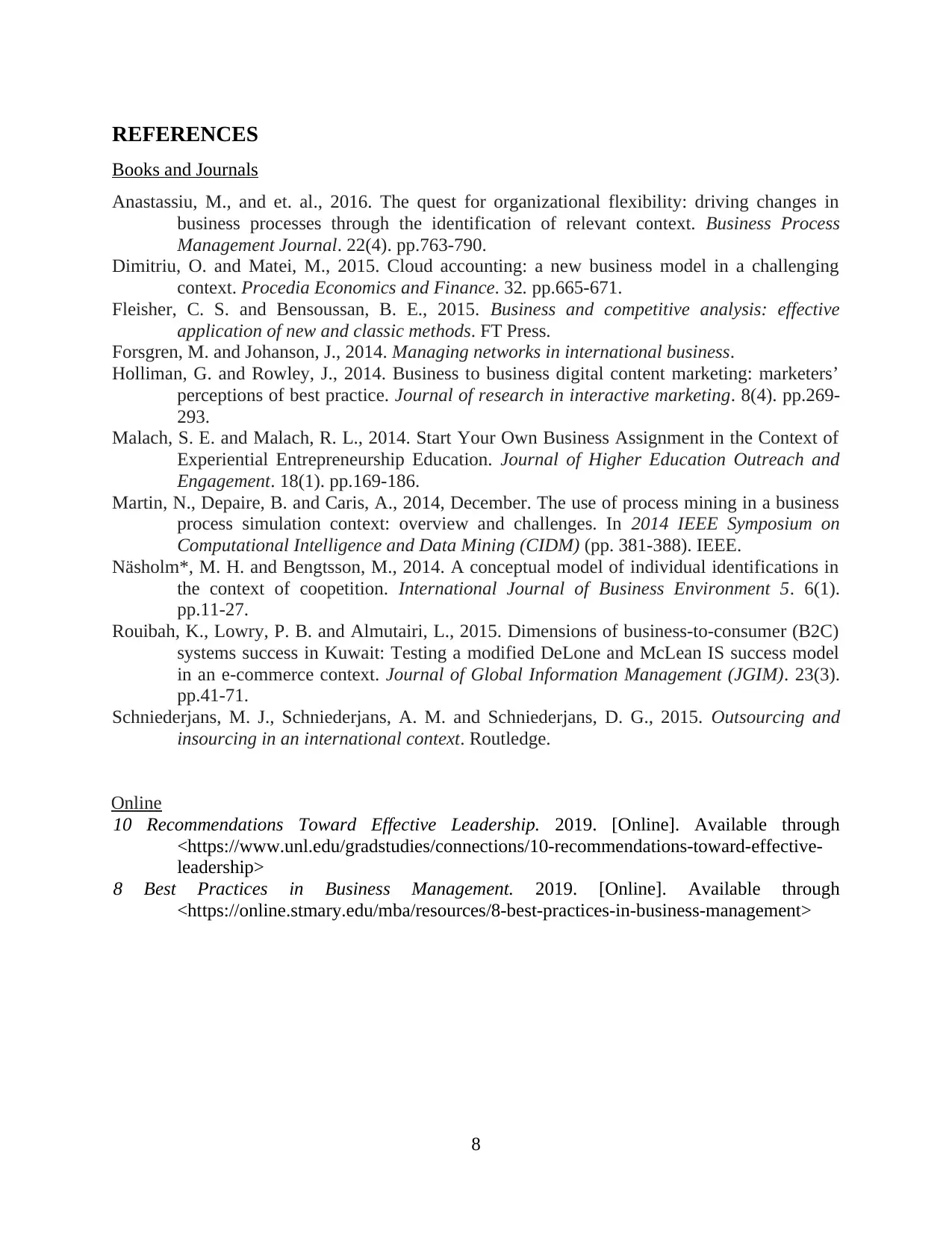
REFERENCES
Books and Journals
Anastassiu, M., and et. al., 2016. The quest for organizational flexibility: driving changes in
business processes through the identification of relevant context. Business Process
Management Journal. 22(4). pp.763-790.
Dimitriu, O. and Matei, M., 2015. Cloud accounting: a new business model in a challenging
context. Procedia Economics and Finance. 32. pp.665-671.
Fleisher, C. S. and Bensoussan, B. E., 2015. Business and competitive analysis: effective
application of new and classic methods. FT Press.
Forsgren, M. and Johanson, J., 2014. Managing networks in international business.
Holliman, G. and Rowley, J., 2014. Business to business digital content marketing: marketers’
perceptions of best practice. Journal of research in interactive marketing. 8(4). pp.269-
293.
Malach, S. E. and Malach, R. L., 2014. Start Your Own Business Assignment in the Context of
Experiential Entrepreneurship Education. Journal of Higher Education Outreach and
Engagement. 18(1). pp.169-186.
Martin, N., Depaire, B. and Caris, A., 2014, December. The use of process mining in a business
process simulation context: overview and challenges. In 2014 IEEE Symposium on
Computational Intelligence and Data Mining (CIDM) (pp. 381-388). IEEE.
Näsholm*, M. H. and Bengtsson, M., 2014. A conceptual model of individual identifications in
the context of coopetition. International Journal of Business Environment 5. 6(1).
pp.11-27.
Rouibah, K., Lowry, P. B. and Almutairi, L., 2015. Dimensions of business-to-consumer (B2C)
systems success in Kuwait: Testing a modified DeLone and McLean IS success model
in an e-commerce context. Journal of Global Information Management (JGIM). 23(3).
pp.41-71.
Schniederjans, M. J., Schniederjans, A. M. and Schniederjans, D. G., 2015. Outsourcing and
insourcing in an international context. Routledge.
Online
10 Recommendations Toward Effective Leadership. 2019. [Online]. Available through
<https://www.unl.edu/gradstudies/connections/10-recommendations-toward-effective-
leadership>
8 Best Practices in Business Management. 2019. [Online]. Available through
<https://online.stmary.edu/mba/resources/8-best-practices-in-business-management>
8
Books and Journals
Anastassiu, M., and et. al., 2016. The quest for organizational flexibility: driving changes in
business processes through the identification of relevant context. Business Process
Management Journal. 22(4). pp.763-790.
Dimitriu, O. and Matei, M., 2015. Cloud accounting: a new business model in a challenging
context. Procedia Economics and Finance. 32. pp.665-671.
Fleisher, C. S. and Bensoussan, B. E., 2015. Business and competitive analysis: effective
application of new and classic methods. FT Press.
Forsgren, M. and Johanson, J., 2014. Managing networks in international business.
Holliman, G. and Rowley, J., 2014. Business to business digital content marketing: marketers’
perceptions of best practice. Journal of research in interactive marketing. 8(4). pp.269-
293.
Malach, S. E. and Malach, R. L., 2014. Start Your Own Business Assignment in the Context of
Experiential Entrepreneurship Education. Journal of Higher Education Outreach and
Engagement. 18(1). pp.169-186.
Martin, N., Depaire, B. and Caris, A., 2014, December. The use of process mining in a business
process simulation context: overview and challenges. In 2014 IEEE Symposium on
Computational Intelligence and Data Mining (CIDM) (pp. 381-388). IEEE.
Näsholm*, M. H. and Bengtsson, M., 2014. A conceptual model of individual identifications in
the context of coopetition. International Journal of Business Environment 5. 6(1).
pp.11-27.
Rouibah, K., Lowry, P. B. and Almutairi, L., 2015. Dimensions of business-to-consumer (B2C)
systems success in Kuwait: Testing a modified DeLone and McLean IS success model
in an e-commerce context. Journal of Global Information Management (JGIM). 23(3).
pp.41-71.
Schniederjans, M. J., Schniederjans, A. M. and Schniederjans, D. G., 2015. Outsourcing and
insourcing in an international context. Routledge.
Online
10 Recommendations Toward Effective Leadership. 2019. [Online]. Available through
<https://www.unl.edu/gradstudies/connections/10-recommendations-toward-effective-
leadership>
8 Best Practices in Business Management. 2019. [Online]. Available through
<https://online.stmary.edu/mba/resources/8-best-practices-in-business-management>
8
1 out of 10
Related Documents
Your All-in-One AI-Powered Toolkit for Academic Success.
+13062052269
info@desklib.com
Available 24*7 on WhatsApp / Email
![[object Object]](/_next/static/media/star-bottom.7253800d.svg)
Unlock your academic potential
Copyright © 2020–2025 A2Z Services. All Rights Reserved. Developed and managed by ZUCOL.





